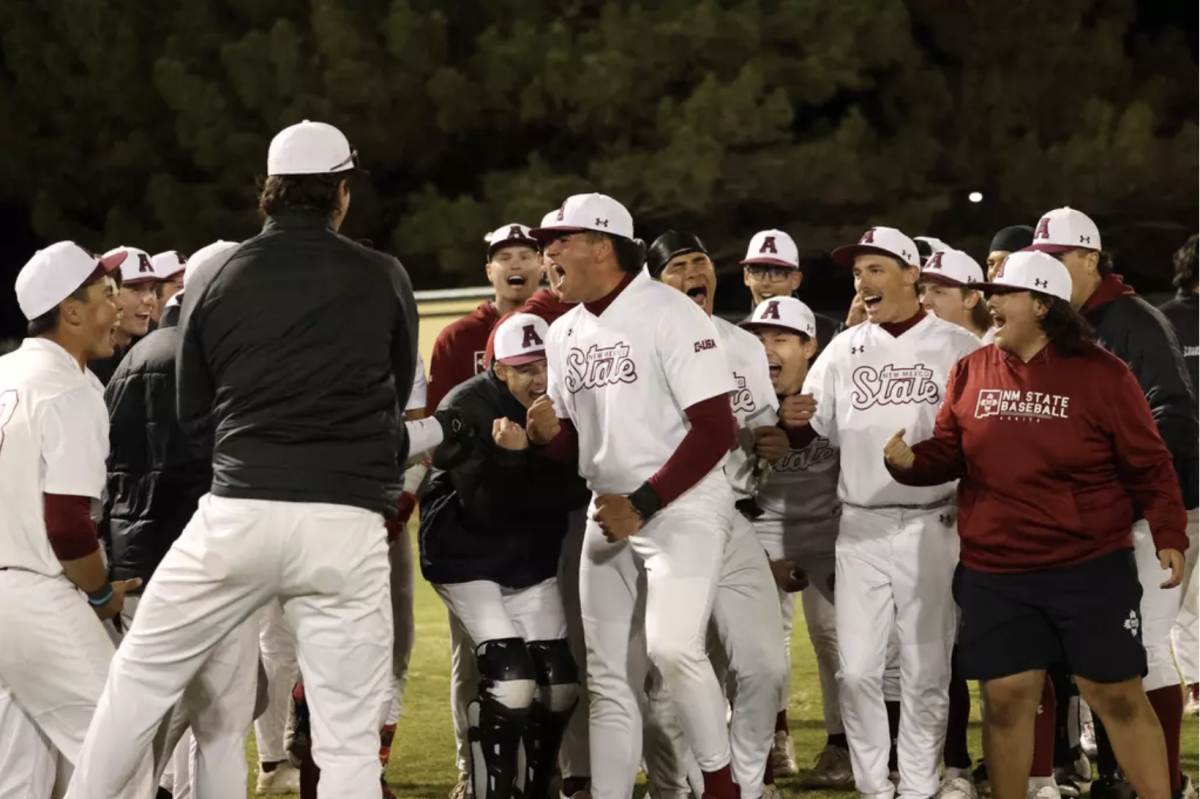By Billy Huntsman
Managing Editor
This is the eighth installment in The Round Up/Oncore Magazine‘s 14-part series investigating professor turnover at NMSU.
Jennie Luna
The Round Up/Oncore Magazine attempted to get into contact with all 10 professors listed above. Only Brown, Durán, Luna, and Rodríguez responded (in addition to Porras’ email).
Despite the time gap between when Eber’s study was published in 2008 and when the 10 professors abovementioned started leaving NMSU in 2011, there are striking similarities between Eber’s respondents’ comments and those of Brown, Durán, Luna, and Rodríguez.
Luna taught at NMSU for two years, beginning in 2012, in the Women’s Studies/Interdisciplinary Studies Department, as well as in the Honors College. At the end of her time here, she submitted a 14,000-word testimonio to, among others, Christa Slaton, dean of the College of Arts and Sciences, and NMSU Provost Dan Howard.
“This document discloses my personal experiences with the relentless institutional racism and racial micro/macro-aggressions at both the departmental and university levels,” she writes.
Luna says soon after her arrival in the department, she was told by three other colleagues in Women’s Studies she was not wanted in the department, nor was her work on Xicana Indígena identity formation pertinent to the department.
“It was made very clear to me that I was a ‘diversity’ hire,” Luna writes.
Luna says at one point early on, a female faculty member approached her and “told me I reminded her of a boyfriend because he was a first-generation migrant and had worked in a field.”
“I attended several Teaching Academy workshops on ‘diversity’ and ‘teaching difficult topics,’ only to find myself outraged at the ways in which unconscious racism was magnified,” she writes. “I learned nothing from these workshops, except how little exposure my fellow faculty had, given their deeply ignorant comments.”
Luna says no one in her department, save one, reached out to her, “not for a cup of coffee, not to offer advice or help with navigating the campus. To this day, no one offered to give me a tour or show me the building we were in, nor how to do mundane things like internal mail.”
Within her first month at NMSU, after a series of email exchanges in which Luna proposed and designed a student survey, which was later altered by a colleague, “I was asked by my chair to have a meeting. In this meeting, I was told that my email tone was abrasive and she (the chair) wanted to have a conversation with me about the way I communicate with others.”
Luna says she left the meeting “feeling silenced and put in my place.”
“I was somehow made to believe that my behavior was antagonistic,” she writes.
Another issue Luna observed, at least within the Women’s Studies Department, was a “lack of a politic of politeness.”
“It has felt like such a struggle to create community or even the desire to build community in WS and in conjunction with students,” she writes.
By November 2012, Luna had been called twice more into the chair’s office.
“I was reprimanded for not responding to emails within 48 hours,” she writes.
She later says neither the chair, the department head, nor any of the other faculty, saving the one, made any effort to “try to get to know me as a human being.”
At another point Luna was admonished for having students waiting outside her office 15 minutes before her office hours were to begin.
“I had never in my life had anyone monitor my office hour presence,” she writes.
A contribution she tried to make to Women’s Studies was arranging a renowned scholar of feminist/women-of-color theory come lecture during Women’s History Month. The lecture took place, though not without hurdles.
Luna had paid for the hotel room and meals for the speaker and the speaker’s partner. In addition, Luna had also volunteered to purchase a gift for the speaker on behalf of the WS Department, which was presented to the speaker after the lecture.
When Luna took her receipts to get reimbursed for her expenses, she was told she could not get reimbursed for some due to university policies. The total amount she could not get reimbursed for “totaled a little over $100.”
“My main issue was that in the faculty meeting (in which she had volunteered to get the speaker a gift), I was told that I could buy her a gift, everyone agreed, and if that was not allowable, I should have been informed,” she writes.
Luna says the WS department chair said “the conversation never happened and that no one said I should buy (the speaker) a gift.”
“I was essentially being told that I was lying or trying to pull one over on the department,” Luna writes.
Her experiences with the Honors College were vastly different from WS.
“Honors College, since the beginning of my time at NMSU, had given me full institutional support and access to space to hold (a) meeting without questioning,” Luna writes.
Following the Women’s History Month lecture, near the end of the school year, “it was decided we would have an outside mediator facilitate a meeting to discuss the communication issues (the WS Department and I) were having during the year.”
An exchange of emails between Luna and the mediator eventually led to Provost Dan Howard, Bill Eamon, former dean of the Honors College, and Christa Slaton, current dean of the College of Arts and Sciences, getting involved. Luna says she was caught in the middle of “personal disputes” between these three and felt like “fodder” in their exchanges.
“It was clear that they did not have a positive relationship,” she writes.
Luna’s end-of-year appraisal received “exceeding expectations” in teaching and professional service, while scholarship and outreach received “meeting expectations.” Despite the struggles she had faced in the department and college, she had published two articles, assisted a student in getting a summer internship with the ACLU, while another three went into graduate school. She served on master’s and Ph.D. committees, fundraised, and took students to academic conferences in Albuquerque and San Antonio. She served as the faculty adviser for Aggies for Feminism, organized two symposiums on campus, and received a research grant.
“I believe I have succeeded (in my first year) and contributed much to the campus and community,” she writes.
Yet she overall felt WS did not recognize her efforts, nor encourage her enthusiasm.
“Instead I felt pushed out,” she writes. “It had been made clear to me that I did not belong in WS, particularly if I did not agree with the status quo or those that were clearly the ‘holders/owners’ of the program. This year (2013-2014), I returned in the fall semester feeling defeated and disenchanted.”
She says her department had only one faculty meeting all semester, at the beginning of the year.
Luna accepted her position California State University Channel Islands before returning for the spring semester. She met with her (new) department head to inform him of her decision to leave.
“(The conversation) avoided addressing the reasons for my leaving nor addressed any feeling of loss for the WS program or desire to inquire if there was anything the department could do to try to keep me at NMSU,” Luna writes.
She once again received notification of having incorrectly used department funds to have Sodexo cater a reception that March. Luna says this could only have happened if she had given Sodexo an index number, which she denied having.
“Once again, during my time here, I am accused of somehow ‘stealing from the department,’” she writes.
Luna says NMSU administrators do not have a clear idea of the diversity on campus. She cites a diversity survey administered to the College of Arts and Sciences faculty and staff inquiring as to how positive the atmosphere of NMSU is to diverse people. The demographic makeup of the respondents to this survey were:
- White: 69 percent
- Hispanic: 16 percent
- Asian: 3.7 percent
- Native American: 2.3 percent
- International and African Americans: less than 1 percent
“And interestingly, 69 percent said that the climate to diverse people is positive or very positive,” Luna writes.
Therefore, she says, the survey enabled NMSU not to have “to do anything about addressing the real issues that communities of color face on this campus.”
She mentions NMSU’s status as a Hispanic-serving institution.
“It is more appropriate to say that NMSU is an Hispanic-collecting institution, with the only priority being the collection of Hispanic students without actually fulfilling any obligation to serve them,” she writes.
She says during HSI Week 2013 (September), faculty and staff received a letter from NMSU President Garrey Carruthers touting NMSU having 47 percent Hispanic students.
“Very little was mentioned about concrete efforts of retention and graduation of Chicano/Latino students today,” she writes. “The fact that this university does not have a comprehensive Ethnic Studies program, nor does it support the development of this academic discipline, is an embarrassment. Further, WS was told a week before that they had to do something to commemorate HSI week and to that end they wanted to borrow (a) display case to put a poster that said ‘HSI pride.’ This was very telling to me that the university puts very little effort, attention, or funding to be meaningful in their ‘pride’ of being HSI.”
Luna says students of color are often used statistically, but are not given much more attention otherwise.
“I had personally dealt with very real issues from my own students that felt marginalized in their classes, could not find access to a person of color therapist in the Health Center, and a grad student who had experienced zero support in her Chicana aesthetic artwork in the Art Department because there were no Chicano/Latino professors (there),” she writes.
Luna says she worries about how students, particularly WS majors, were by her leaving.
“In my first year, the number of women students of color that came to me and were drawn to my courses showed me that there was a deep gap in WS that had not been addressed,” she writes. “One Black student, WS major, came to me and said that in the four and a half years she had been at NMSU, she had never had one class as a WS major where Black feminism was discussed or had anything to do with African Americans. In her entire education at NMSU, there was never any mention of Black issues, with the exception of one anthropology course that only framed Africans as subject-specimens.”
Luna says she heard similar stories from Mexican Americans, Chicanas, and Native Americans.
“I have been appalled by the ways in which the Native faculty and staff have been purposely excluded from decision-making spaces,” Luna writes. “My participation in the Tribal Voices Working Group only revealed to me the deep level of racism and erasure that happens even when Native voices and members request to be at the table when important decisions, such as the selection of the president of the university, are made.”
Near the end of her second and final year, Luna was asked to return her university-provided computer. She “had been told at the beginning of the year that if it was under $1,000 that I would be able to keep (it.)” Luna says she confirmed this with senior faculty members.
“‘About the computer, it is all university property and those that take their computers are called thieves,’” Luna quotes her department head.
Yet again, Luna says, she was accused of thievery “up until my last moment here.”
“Overall, my experience within WS has been to sink or swim—little support or access was given to me to survive or thrive,” she writes.
As a woman of color, first-generation college student, and someone who relates to the majority of the student population at NMSU, she writes, “my departure comes at a price to the students. I came to an Hispanic-serving institution expecting a certain level of knowledge about the population, holding a certain value system that welcomes and encourages and recognizes everyone’s worth.”
The reality at NMSU did not live up to her expectations, she writes.
Laura Anh Williams, program director for Women’s Studies since 2012, frequently interacted with Luna. She gave her responses to Luna’s memo.
“The comments in the memo reflect neither my experiences nor my interactions with her, nor do they accurately reflect my experiences in Women’s Studies or with other Women’s Studies faculty,” Williams says in an email. “Women’s Studies took action on initiatives she proposed. She is an outstanding scholar who received support at the college and departmental level for her work and teaching, as well as the encouragement of faculty within as well as outside of the department.”
Patricia Wojahn, who has served as interim head of the department for the past three months, did respond to our request. Though she was not involved with the department during Luna’s time, Wojahn says the department has dedicated faculty.
“I am honored to be working with every one of these faculty members, and I have gained much from my experience with them thus far,” Wojahn says. “We are discussing top-notch teachers who have been nominated for and even won university-wide teaching awards, and a group who just this past year won the Arts & Sciences Exceptional Achievement in Diversity Award.”






